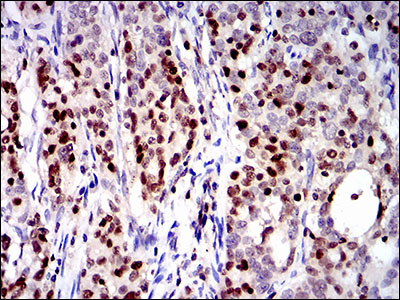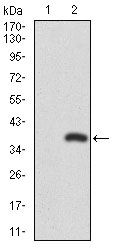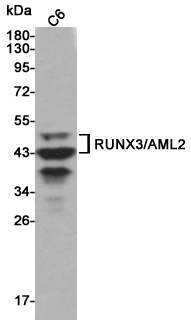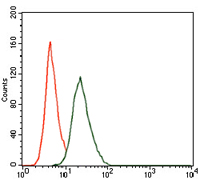-
Product Name
Anti-RUNX3 (4H2) Mouse antibody
- Documents
-
Description
RUNX3 (4H2) Mouse monoclonal antibody
-
Tested applications
WB, IHC-P, ICC/IF, FC
-
Species reactivity
Human, Mouse
-
Isotype
Mouse IgG2b
-
Preparation
Antigen: Purified recombinant fragment of human RUNX3 (AA:186-252) expressed in E. Coli.
-
Clonality
Monoclonal
-
Formulation
Purified antibody in PBS with 0.05% sodium azide
-
Storage instructions
Store at 4°C short term. Store at -20°C long term. Avoid freeze / thaw cycle.
-
Applications
WB: 1/500 - 1/2000
IHC: 1/200 - 1/1000
ICC: 1/200 - 1/1000
FC: 1/200 - 1/400
ELISA: 1/10000
-
Validations

Immunohistochemical analysis of paraffin-embedded cervical cancer tissues using RUNX3 mouse mAb with DAB staining.

Western blot analysis using RUNX3 mAb against HEK293 (1) and RUNX3 (AA: 186-252)-hIgGFc transfected HEK293 (2) cell lysate.

Western blot detection of RUNX3/AML2 in C6 cell lysates using RUNX3/AML2 mouse mAb (1:5000 diluted).Predicted band size:44KDa.Observed band size:43~48KDa.

Flow cytometric analysis of NIH3T3 cells using RUNX3 mouse mAb (green) and negative control (red).
-
Background
Swiss-Prot Acc.Q13761.This gene encodes a member of the runt domain-containing family of transcription factors. A heterodimer of this protein and a beta subunit forms a complex that binds to the core DNA sequence 5'-PYGPYGGT-3' found in a number of enhancers and promoters, and can either activate or suppress transcription. It also interacts with other transcription factors. It functions as a tumor suppressor, and the gene is frequently deleted or transcriptionally silenced in cancer. Multiple transcript variants encoding different isoforms have been found for this gene.
Related Products / Services
Please note: All products are "FOR RESEARCH USE ONLY AND ARE NOT INTENDED FOR DIAGNOSTIC OR THERAPEUTIC USE"
